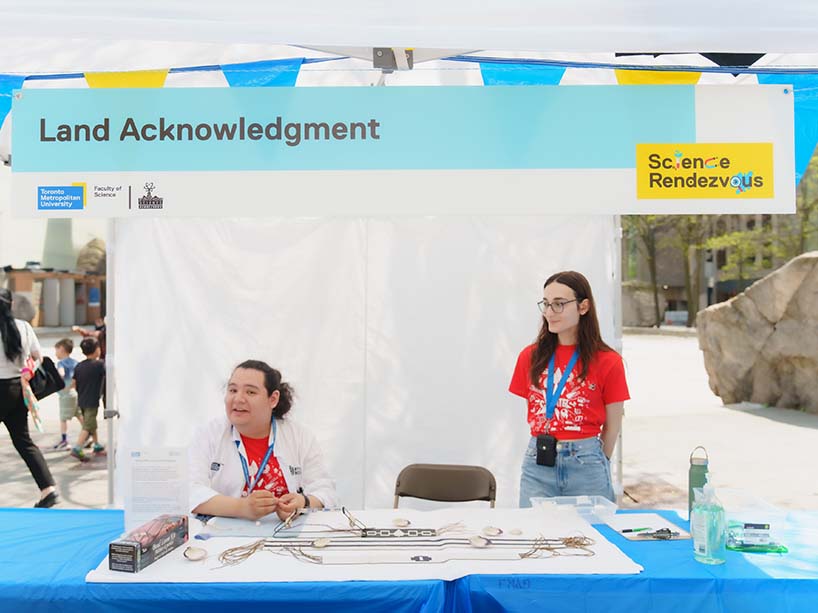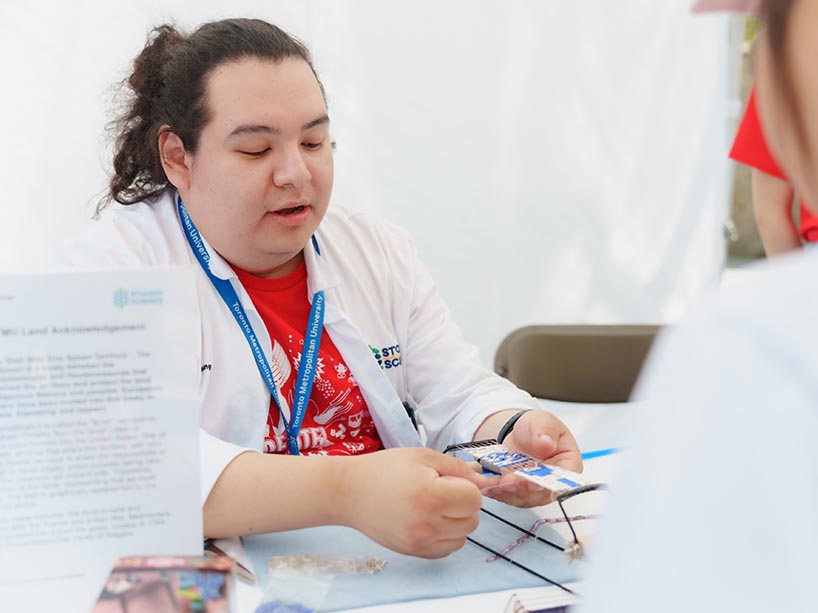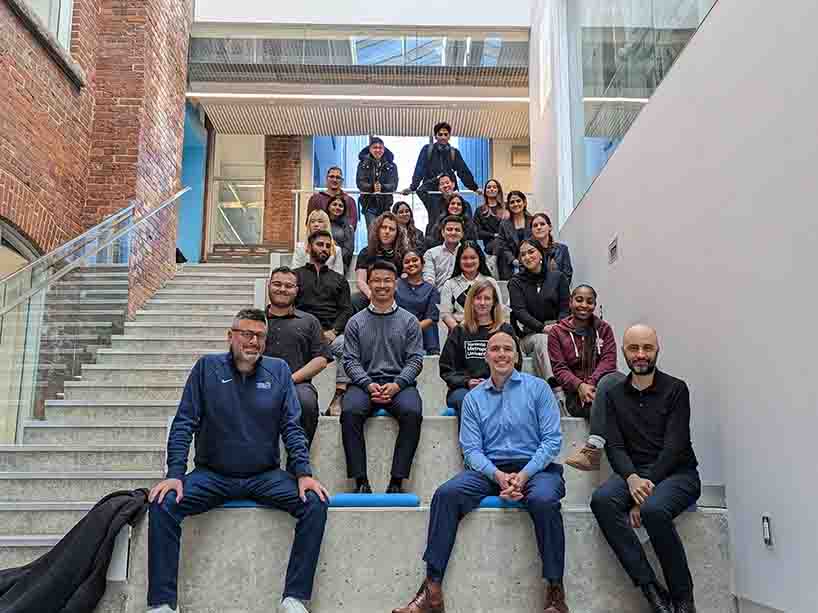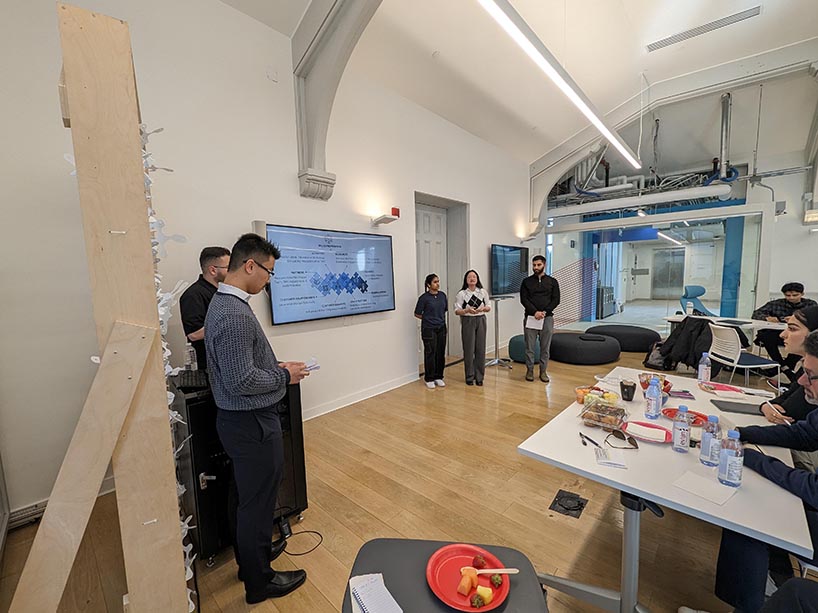This National Indigenous Peoples Day, TMU reflects on access to education

Caleb Wesley, co-ordinator, Indigenous knowledge and science outreach at SciXChange in the Faculty of Science, and Allie Spangaro, a volunteer TMU student, at their booth for Science Rendezvous, which brings STEM to youth.
As a young child in early grade school, Caleb Wesley experienced structural discrimination firsthand.
“In grade three, I was living in North Bay, and I just didn’t feel good in my teacher’s classroom. I got my first detention that year because I was coming late to school by 5 or 10 minutes. My mother was a single mother in her early 20s trying to make it outside of her home community and go to college at Canadore College, while having two young children,” says Wesley, now the co-ordinator, Indigenous knowledge and science outreach at SciXChange in the Faculty of Science.
“The way this teacher approached education, the way she set up her classroom, the way she handled discipline and truancy all had reverberating effects on my own mental health at the time,” he says. “She put all the Indigenous students in the back of the class or along the wall so that our visibility was blocked. I remember sitting behind a filing cabinet so I couldn't see the board.”
“The weaponization of education against Indigenous Peoples has resulted in the mass alienation of Indigenous Peoples from the education system, and a general distrust of public institutions.”
Wesley isn’t alone in his experience. And having an experience like this – or oftentimes, more than one – throughout your educational journey leaves a lasting impression. That’s why, he says, increasing access and breaking down barriers to education starts much earlier than at the post-secondary admissions table.
“We have to see how we can begin to make educational spaces accessible for Indigenous folks in a holistic way,” he says. “If we want to see changes in Indigenous student representation in the post-secondary space, we need to foster those relationships early on, and we need to be supporting these students across their education journey, not just when they come to our institution.”
Michael Mihalicz, professor and Indigenous advisor at the Ted Rogers School of Management, sees the same challenges for Indigenous students in his faculty, and higher education more broadly. “An underlying factor responsible for the lower rates of educational attainment among Indigenous students is the systemic underfunding of schools in Indigenous communities. This limits the ability of these schools to provide extracurricular activities, up-to-date books, science labs and modern technology that would help promote student interest in higher education. Students sometimes come from communities where they don’t even have access to courses that are prerequisites to many university programs. Essentially, this renders anyone growing up in those communities ineligible for many, if not most university programs,” he says.
“Access to education is an inherent and a treaty right for Indigenous Peoples in Canada yet the Government of Canada has time and time again failed to live up to its obligations. Instead of honouring the treaties and promises made by the Queen and the government, they created the residential school system to eradicate Indigenous culture and assimilate Indigenous peoples into Euro-Canadian society. The weaponization of education against Indigenous Peoples has resulted in the mass alienation of Indigenous Peoples from the education system, and a general distrust of public institutions.”
Showing up for students much earlier
In his role within SciXChange, Wesley focuses on science outreach engagement for Indigenous communities. “When I joined TMU in July 2022, I identified urban Indigenous community centres and Indigenous focused schools in the Toronto District School Board, and I built relationships with Wandering Spirit School, Native Learning Centre and the Urban Indigenous Education Centre, so that the resources and expertise we have here at TMU can be brought to these Indigenous students in their classrooms.”

Caleb Wesley has spent the last year building relationships with Indigenous youth in elementary and high schools to increase access to post secondary education.
In any given week, Wesley supports different elementary or high school students through the science curriculum, while bringing Indigenous stories, language and arts into the teaching. “For example, in grade 9 and grade 10 science, students have to do a dissection,” he says. “The traditional way of doing a dissection is to purchase a preserved specimen from a supplier that is specifically killed for the purpose of dissection, pumped full of toxic chemicals and then packaged up and shipped off to schools.”
Eventually these specimens make their way to the landfill or an incinerator, but Wesley wanted to shift the approach to this classroom requirement.
“We sourced pickerel from a local fishmonger and we taught the students both the internal and external anatomy of the fish, but we also taught the students how to clean, skin and filet the fish. We were actually harvesting the meat from the fish, so we're connecting it to Indigenous ways of knowing, being and doing by being more holistic in the way that we approach science. And in doing so, we're centring Indigenous Peoples, and we're saying if you’ve ever gone fishing, this is an example of science.”
Creating a space to flourish for all
Seeing one’s self in educational practices and spaces is a necessary step to success. One reason the education gap persists, says Mihalicz, is because Indigenous students often feel as though they don't belong within university spaces. This is particularly prominent in business education, where he says many students feel as though business is antithetical to Indigenous worldviews. “This couldn't be further from the truth but it plays to that narrative that was very intentionally crafted, that trade and business was something that Europeans brought with them and gave to Indigenous Peoples.”
As Indigenous advisor to the faculty, Mihalicz’s role is to lead the development of protocols and processes that address barriers to Indigenous student enrollment. “I'm approaching this through an end-to-end recruitment and retention strategy. It's a more holistic approach that aims at making the physical space, the curriculum and the community more inclusive, as well as creating multiple paths to TRSM for Indigenous students. And so the whole idea is to bring more students to TRSM and then bring those voices to the table to shape our efforts around what students actually value.”
Indigenizing the curriculum at TMU
TRSM is trying to change this way of thinking through their programming and the way they interface with students, says Mihalicz.
“We didn't just want to go out and get a whole bunch of students to submit applications to TRSM; we started out with the Indigenous Awareness Training Program to help student-facing staff in TRSM engage more effectively with Indigenous students, and an Indigenous admissions stream designed to address systemic barriers by eliminating competition in the selection admission of Indigenous applicants to all TRSM programs. This laid the foundation for a lot of the recruitment and retention initiatives that would follow.”

Michael Mihalicz, professor and Indigenous advisor at the Ted Rogers School of Management, created a design thinking course within the faculty that brought Indigenous high school students together with TMU business students to design the university they want.
Mihalicz also created a new design thinking experience course, which brought Indigenous high school students together with TMU students to design the university that they want.
“The idea was to bring these students together with TMU students to know how to make the space more inclusive,” he says. “Students worked on a variety of different initiatives, but the whole idea was to bring these two perspectives together to reimagine a better approach to education.”
Indigenizing the curriculum isn’t an overnight project, says Wesley, noting that it takes years to build and enact transformative change.
“But we can’t let that thought bog us down,” he says. “Think about how much education has changed over the last seven generations: my mother just missed the Day School days, all my grandparents went to residential school. So our work today is not some microcosm, but it's been started generations back.
“To envision our future, we need to think about what the next generation will experience and the one after that, and then we can begin to build these Indigenized and decolonized futures. We need to think about this work in the context of seven generations, thinking seven generations back and seven generations forward. I think TMU is primed for success in these ventures because we recognize this as an important aspect of our work.”

The design thinking course allowed students to work collaboratively to envision a university for all.